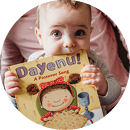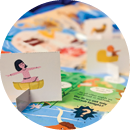How flexible does a book need to be to make it through US postal machines?
How do books make it to places like Shanghai and Singapore?
How do we ensure a family can use our resources for years to come?
This is a small sample of the questions we answer on any given day at the home office in western Massachusetts. The operational challenges associated with getting 650,000 books written, illustrated, printed, packed, and distributed in 21 countries are fascinating and never-ending. And we need to get it right, because spending an extra ten cents per delivery costs more than $60,000 when you consider the size and scope of PJ Library. From tariffs to packaging, we strive to make decisions that elevate the family experience while ensuring the program can continue on for generations. Here are just a few of the unique considerations we’ve made over the years:

A BIG CHANGE TO BOARD BOOKS
I bet you didn’t notice the postage flexibility rule change of 2010. The rule change required mail to meet a certain level of flexibility to be considered “flat mail.” Our earliest board books did not meet these requirements, so we worked with our publishing partners to employ a different type of paper. Now PJ Library board books are sturdy enough for the hands of toddlers but flexible enough for postage machines. And even big-name publishers are starting to use this paper.

AROUND THE WORLD
Due to customs restrictions, families in Shanghai can subscribe to PJ Library only because volunteers pick up the books in Hong Kong and bring them back to Shanghai.
In Singapore, a 15-year-old boy named Elijah receives the books at his flat and brings them to synagogue once a month to distribute to other children. He took on the role as his Tikkun Olam (repairing the world) project for his Bar Mitzvah.

KNOW WHEN TO SPEND
When we produced the Passover River Ride Game in early 2019, the idea was to print the board game on regular paper. It was inexpensive and would fold nicely to fit into the envelope. But the team hoped this could be a game that families would put away and save for next year’s Passover, so we spent a little more to laminate the activity so it would make it through a seder as well as a year in storage.